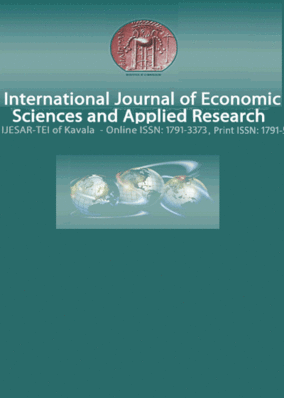Role of fiscal policy for private investment in Pakistan
Part of : International Journal of Business and Economic Sciences Applied Research ; Vol.7, No.2, 2014, pages 139-152
Issue:
Pages:
139-152
Author:
Abstract:
Fiscal policy has much controversial debate regarding its effectiveness on private investment. Taxation and government expenditure are two main instruments of fiscal policy. This paper is aimed to analyze the effect of fiscal deficit and other variables on private investment of Pakistan. The data time span for this study is 1979-2012. After finding the integration order of all variables by Augmented Dicky Fuller Test, the impact of variables is analyzed by utilizing the Auto Regressive Distributed Lag approach of Cointegration which is a better estimation technique for small sample size. Error Correction Model is applied for short run dynamics. The results reveal that fiscal deficit, rate of interest, inflation and external debt are affecting negatively the private investment in Pakistan while exchange rate and exports have a positive impact on private investment.
Subject:
Subject (LC):
Keywords:
fiscal policy, private investment, co integration
Notes:
JEL Classification: E62, C22, Περιέχει σχέδια, πίνακες και βιβλιογραφία
References (1):
- Aisen A. and Hauner D., 2008, ‘Budget Deficits and Interest Rates’, IMF Working Paper, 42, pp. 1-21.Ahmad I. and Qayyum A., 2008, ‘Effect of Government Spending and Macroeconomic Uncertainty on Private Investment in Services Sector: Evidence from Pakistan’, European Journal of Economics, Finance and Administrative Sciences ISSN 1450- 2275 Issue 11.Alesina A. et al., 2002, ‘Fiscal Policy, Profits and Investment’, The American Economic Review, 92, 3, June 2002, pp. 571-589.Ali S. and Ahmad N., 2010, ‘The Effects of Fiscal Policy on Economic Growth: Empirical Evidences Based on Time Series Data from Pakistan’, The Pakistan Development Review, 49:4 Part II (Winter 2010) pp. 497-512.Aschauer D., 1989, ‘Is Public Expenditure Productive?’, Journal of Monetary Economics, 23, pp. 177-200.Bahmani-Oskooee, 1999, ‘Do Budget Deficits Crowd in or Crowd out Private Investment: Evidence from Europe’, International Journal of Public Policy, 1, pp. 223-232.Baldacci, Emanuele, Hillman, Arye L. and Naoko C. Kojo, 2004, Growth, Governance and Fiscal Policy Transmission in Low-Income Countries, IMF Working Paper WP/03/237.Beck S.E., 1993, ‘Ricardian Equivalence Proposition: Evidence from Foreign Exchange Markets’, Journal of International money and Finance, 12 (May), pp. 154-169.Blanchard O.J., and Perotti R., 2002, ‘An Empirical Characterization of the Dynamic Effeects of Changes in Government Spending and Taxes on Output’, Quarterly Journal of Economics, 117,4, pp. 1329.1368.Blejer M.I. and Khan M.S., 1984, ‘Government Policy and Private Investment in Developing Countries’, Staff Papers, International Monetary Fund, 31 (June), pp. 379-403.Buiter, Willem, 1999, ‘The Fallacy of the Fiscal Theory of the Price Level’, Economic Journal, NBER Working Paper, 7302.Chaudhary, M.A. and Abe K., 1999, ‘Pakistan economy: Past Trends, Current Situation and Future Prospects’, Chiba University Economic Journal, 14, 1, pp. 49-85.Darrat A.F., 1998, ‘Having Large Budget Deficits Caused Rising Trade Deficits?’, Southern Economic Journal, 54, pp. 879-87.Dotsey M., 1994, ‘Some Unpleasant Supply Side’, Arithmetic Journal of Monetary Economics, 33, pp. 507-524.Edelberg, Wendy, Martin Eichenbaum and Jonas Fisher, 1998, ‘Understanding the Effects of a Shock to Government Purchases’, NBER Working Paper, No 6737.Fatima G., Ahmad A.M., and Rehman W., 2011, ‘Fiscal Deficit and Economic Growth: An Analysis of Pakistan’s Economy’, International Journal of Trade, Economics and Finance, 2, 6.Greene J. and Villanueva, 1991, Private investment in developing countries, IMF staff papers, 38.Husnain M.I., Khan M., Padda I., Akram N. & Haider .A, 2011, ‘Public Spending, Foreign Direct Investment and Economic Growth: A Time Series Analysis for Pakistan (1975- 2008)’, International Research Journal of Finance and Economics, 61, pp. 21-27.Hyder K., 2001, ‘Crowding-out Hypothesis in a Vector Error Correction Framework: A case study of Pakistan’, The Pakistan Development Review, 40,4, pp. 633-650.Looney E., 1995,‘Public Sector Deficits and Private Investment: ATest of the Crowding- out Hypothesis in Pakistan’s Manufacturing Industry’, The Pakistan Development Review, 34, 3, pp. 277-292.Paiko 1.1., 2012, ‘Deficit financing and its Implication on Private Sector Investment: The Nigerian Experience’, Arabian Journal of Business and Management Review, 1,9, April 2012, pp. 45-62.Rama M., 1993, ‘Empirical Investment Equations for Developing Countries’, Working Paper, The World Bank, Washington, D.C.Riberio M. and Joanilio T.R., 2003, ‘An Econometric Analysis of Private Sector Investment in Brazil’, CEPAL Review 7, 4.Solimano A., 1992, ‘Understanding the Investment Cycle in Adjustment Programs: Evidence from Reforming Economies’, PRE Working Paper No.912.State Bank of Pakistan, 2010, Handbook of Statistics on Pakistan Economy, SBP, Karachi, Pakistan.Uzair M., 2004, Economy of Pakistan: Perspective and Problems, Karachi: Royal Book Company, Karachi.




